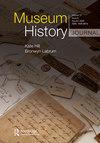Fitting the colonial museum dashboard? Civic action, curatorial agency and identity building at the Auckland Museum (1852–1929)
IF 0.2
Q3 HISTORY
引用次数: 1
Abstract
ABSTRACT John MacKenzie in his Museums and Empire (2010) sets out an evolutionary framework of museum development in the British settler colonies. The formation years of the Auckland Museum in New Zealand both align and misalign with this progressive imperial model. In contrast to the establishment of the first Australian museums, which were essentially state sponsored enterprises, the Auckland Museum experience of the second half of the nineteenth century is one of curatorial agency, civic action and identity building in New Zealand's second capital city. In addition, the tentative reciprocal relationships with Māori in the rapid growth of the indigenous cultural collections are a defining feature of this phase of intensive acquisition and expansion. Imperial aspirations only came with WW1 when the future Auckland Museum was re-imagined as being ‘essential to complete the equipment of men and women who are to lead the work of progressive civilisation' and a new museum architecture of Empire was conceived. Whilst referencing the prevailing museological framework for the study of early museums in British settler colonies, this article concentrates less on the theory of Empire and more on local biography, collecting impulses and archival histories of the Auckland Museum during its formative years, now one of New Zealand’s most extensive cultural assets.安装殖民博物馆的仪表盘?奥克兰博物馆的公民行动、策展机构和身份认同建设(1852-1929)
约翰·麦肯齐在他的《博物馆与帝国》(2010)中提出了英国殖民殖民地博物馆发展的演化框架。新西兰奥克兰博物馆的形成年代与这种进步的帝国模式既一致又不一致。第一批澳大利亚博物馆基本上是由国家赞助的企业,与之相反,奥克兰博物馆在19世纪下半叶的经历是新西兰第二首都的策展机构、公民行动和身份建设之一。此外,在本土文化收藏的快速增长中,与Māori的初步互惠关系是这一密集收购和扩张阶段的一个决定性特征。帝国的愿望只有在第一次世界大战之后才出现,当时未来的奥克兰博物馆被重新设想为“完成领导进步文明工作的男人和女人的设备的必要条件”,并且构想了一个新的帝国博物馆建筑。虽然参考了英国殖民殖民地早期博物馆研究的流行博物馆学框架,但本文较少关注帝国理论,更多地关注当地传记,收集奥克兰博物馆在其形成时期的冲动和档案历史,现在是新西兰最广泛的文化资产之一。
本文章由计算机程序翻译,如有差异,请以英文原文为准。
求助全文
约1分钟内获得全文
求助全文

 求助内容:
求助内容: 应助结果提醒方式:
应助结果提醒方式:


